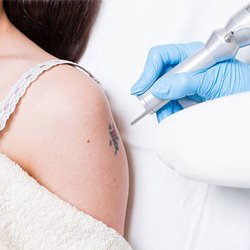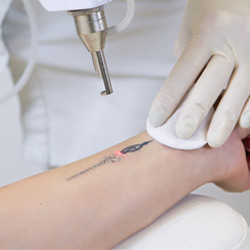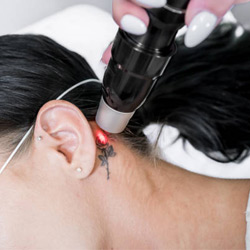


TATTOO REMOVAL
Leaving the skin free of ink
- No scarring
- Effective fading and removal of tattoos
- lasting effects
Once the tattoo is gone, it’s gone forever. If you don’t like your tattoo, it’s a worthwhile expense.
1. How long will it take to remove my tattoo?
The duration of the tattoo removal process is a concern for virtually all patients.
Some patients may wish to remove a visible tattoo before an event – such as their wedding or enlisting in the military. It’s important to establish upfront that tattoo removal is a process that relies on the body’s ability to eliminate ink from the skin.
It’s not unusual for the body to take over a year to completely eliminate ink. Setting expectations clearly upfront allows patients to be satisfied throughout the experience – rather than feeling as if they were misled.
To allow the skin enough time to heal between treatments and the body’s immune system to flush away ink, we recommend a minimum of FOUR TO FIVE WEEKS between laser sessions – and eight weeks for darker complexions. Stacking the treatments too close together can cause damage and permanent side effects to the skin and doesn’t allow the body enough time to remove the ink that was shattered at the most recent session. For ideal results, we recommend waiting ONE month between treatments.
Tattoo removal treatments fit along a bell curve – most patients will need between FIVE and TWELVE treatments, some will see complete removal in three or four, and others may need 10 or more treatments if there is significant scarring or layered tattoos. We suggest to patients where they are likely to fit along the bell curve based on the unique factors of their tattoo.
There are also other factors, such as patient health, that affect the speed of removal. If a patient is young, physically fit, and has a strong immune system, they will tend to see results faster than an older, obese patient with health problems. Encouraging patients to exercise, drink ample water, and massage the treated area (once healed) are good aftercare tips to share with patients looking to get the best results.
Picture Gallery




2. Does tattoo removal hurt?
Laser tattoo removal typically does involve some level of pain. That said, many say that it hurts less than they expected.
It’s a common belief that tattoo removal is excruciating, yet most patients say that the sensation of removal is comparable to having a tattoo applied. Common descriptions include the sensation of a rubber band snapping against the skin or bacon grease – basically, it’s uncomfortable but bearable.
It hurts, but it’s bearable.
Laser tattoo removal typically does involve some level of pain. That said, many say that it hurts less than they expected.
Integrated wellness Offers skin numbing to keep patients feeling happy
3. Will it leave a scar?
Many patients are concerned about scarring from laser tattoo removal – they understandably want their skin to look as natural as possible after they’ve completed the tattoo removal process.
If the tattoo already features scarring, expect that to remain.
What many people don’t know is that any scarring that remains after a tattoo removal procedure is often left over from when the tattoo was originally applied by the tattoo artist.
When the proper laser protocols and patient aftercare are utilized, it’s very uncommon for a patient to scar from a Q-switched laser treatment. However, it is very common for a tattoo to feature pre-existing scarring from when it was applied.
When a Q-switched laser treats the skin, it targets and breaks down the tattoo pigment in the skin. If pre-existing scarring is present, it will break down this pigment within the scar tissue. Once the tattoo removal process is complete, the ink will have been eliminated from the location but any of the scarring from the original tattoo will likely still remain.
During the initial consultation while you are assessing the tattoo, touch it and see if pre-existing scarring is present. If so, mark it as such in the patient’s records and inform the patient that the laser will not eliminate scar tissue, just their ink.
4. How does laser tattoo removal work?
Many patients have the misconception that the laser “burns” the tattoo ink out of the skin.
Each pulse of the laser sends light energy into your skin. We use different wavelengths of laser light to treat different colors of ink in your tattoo. As the light energy is directed into your skin, it is selectively absorbed by the tattoo ink particles trapped in the dermis of your skin. When the ink particles absorb this energy, they instantly shatter into tiny fragments. Once the laser has broken the ink into smaller pieces, your body’s immune system works to remove the ink over the following weeks, flushing it away from the tattooed area. We see the result of this as the tattoo lightening in appearance. Each additional laser treatment breaks down more and more ink until the tattoo can no longer be seen.”
Informed Patients are Happy Patients
FAQS
IS THIS TREATMENT SUITABLE FOR ME?
There are certain things that make individuals good candidates for laser tattoo removal. Usually, individuals who have fair skin and have a dark tattoo get the best results. Something else that will determine if you are a good candidate for this procedure is the density of your tattoo. If the tattoo is extremely dense, you may not get to the most satisfactory results.
HOW OFTEN DO I GET THIS TREATMENT?
Stacking the treatments too close together can cause damage and permanent side effects to the skin and doesn’t allow the body enough time to remove the ink that was shattered at the most recent session. For ideal results, we recommend waiting ONE month between treatments.
